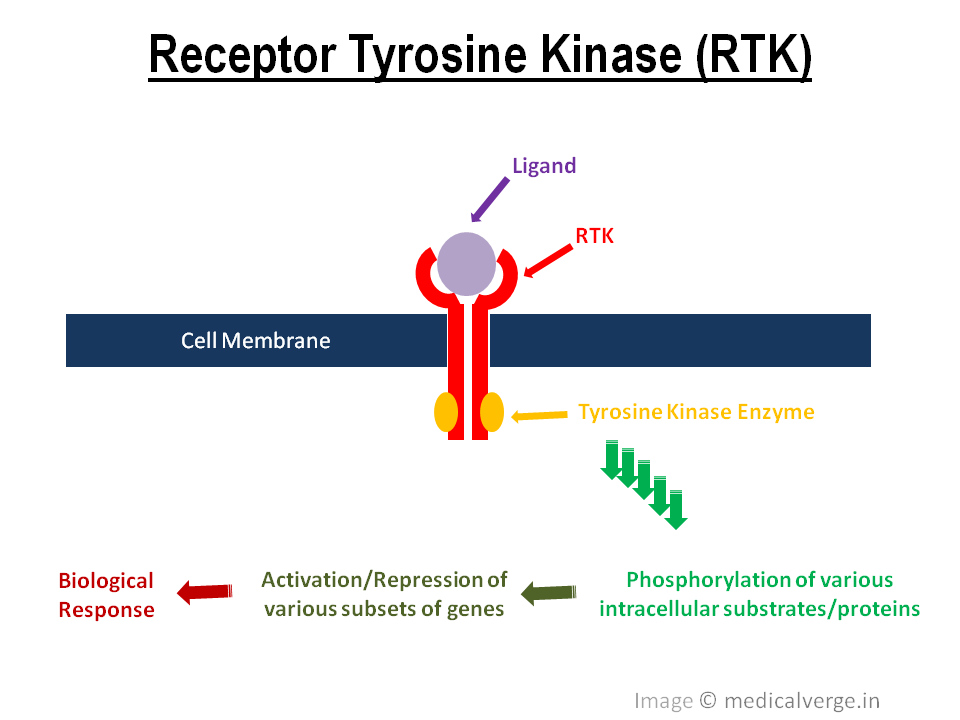Tyrosine Kinase Inhibitors are small molecules, used as targeted anticancer drugs. Unlike conventional cytotoxic chemotherapy, which indiscriminate between the cancer cells and normally rapidly dividing cells in the body, tyrosine kinase inhibitors have more specificity towards cancer cells. Comparatively much less adverse effects such as Bone marrow suppression, Alopecia and Diarrhea.
On discovery of the Philadelphia chromosome, which is a translocation of chromosome 9 and 22 leads to fusion of abl and bcr genes seen in CML (chronic myeloid leukemia) causing over-activation of the tyrosine kinase enzyme. On finding of this pathogenesis in CML, the first tyrosine kinase inhibitor ‘Imatinib’ was developed in 1998 and approved by FDA in 2001 for the treatment of CML. Over time, many studies have been found that the expression of tyrosine kinase has been shown in many other tumors as well, though activation is different in different tumors. As a result of this knowledge, a number of tyrosine kinase inhibitors have been developed to treat many cancers. Currently, numerous drugs are approved by the FDA and some are in the pipeline.

Tyrosine kinases
Tyrosine kinases are the enzymes that are important for cellular pathway, linked to the intracellular domain of various receptors, e.g., receptors of growth factor, cytokines, and hormones etc.
- Receptor tyrosine kinase
- EGFR (Epidermal Growth Factor Receptors)
- PDGFR (Platelet Derived Growth Factor Receptors)
- FGFR (Fibroblast Growth Factor Receptors)
- IR (Insulin Receptors)
- Non- Receptor tyrosine kinase
- ABL, Janus kinase, FAK, SRK
Mechanism of Action
A ligand bind with the two receptors, e.g. GH (1:2 :: ligand:receptor), or two ligand bind simultaneously with two receptors e.g. VEGF (2:2 :: ligand:receptor).
Ligand (e.g. EGF, PDGF) binding to extracellular domain –>Receptor dimerization (except Insulin receptor) –>Activation of tyrosine kinase enzyme –>selective phosphorylation of tyrosine residue of different intracellular substrates/proteins –>Activation of a cascade of intracellular biochemical signals –>Activation or repression of various subsets of genes –>Biological response.

classification on the basis of targets
- BCR-ABL tyrosine kinase inhibitors
1st generation – Imatinib
Imatinib also inhibits cKIT (CD117) and PDGFR tyrosine kinases. It is well tolerated and has less side effects as compared to cytotoxic drugs. Adverse effects include bone marrow suppression, peripheral edema, muscle cramp, skin rash and increased liver Transaminase enzyme.
2nd generation – they are more tolerable and less risk of resistance development.
This includes Nilotinib, Dasatinib, Bosutinib, Ponatinib and Bofetinib.
- EGFR tyrosine kinase inhibitor
There are 4 types of EGFR receptors are identified, ErbB1 (EGFR/HER1), ErbB2 (HER2/new), ErbB3 (HER3) and ErbB (HER4).
Selective ErbB1 inhibitors – Gefitinib, Erlotinib
Selective ErbB1 & RrbB2 inhibitors – Lapatinib
Non-selective ErbB inhibitors – Canertinib
- VEGFR tyrosine kinase inhibitor
VEFG is secreted by almost all solid tumors in response to hypoxia. Excessive expression of VEGF may be related to increased microvascular density, cancer recurrence and decreased survival of the patient.
This includes Semaxinib, Vatalanib and Sorafenib.
Sorafenib was originally developed as Raf-kinase inhibitor, but later on found in studies that it also inhibit VEGFR, EGFR and PDGFR.
- PDGFR tyrosine kinase inhibitor
Toceranib, Nintedanib
- Non-selective tyrosine kinase inhibitor
Sunitinib
It is a multi-targeted tyrosine kinase inhibitor, including VEGFR, PDGFR, Raf-1, Flt-3 and cKIT.
Uses of tyrosine kinase inhibitors
- CML (chronic myeloid leukemia)
Imatinib (DOC), Nilotinib, Dasatinib
- Lung carcinoma (NSCLC)
Afatinib, Ceritinib, Erlotinib, Geftinib
- RCC (renal cell carcinoma)
Axitinib, Pazopanib, Sunitinib, Sorafenib
- HCC (hepatocellular carcinoma)
Sorafenib
- GIST (gastrointestinal stromal tumor)
Imatinib (DOC), Sunitinib, Regorafenib
- Malignant melanoma
Dabrefenib, Vemurafenib, Trameltenib
- Colorectal carcinoma
Regorafenib
- MCT (medullary carcinoma of thyroid)
Vandetanib
- Breast carcinoma
Lapatinib, Canertinib